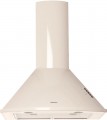Minimum noise level
The volume at which the device operates in the quietest mode. Usually (but not necessarily) it is the minimum power mode.
The decibels in which the noise level is measured are non-linear units, so it is easiest to use comparison tables to estimate a specific value. Here is the simplest table for minimum noise in modern hoods:
— 20 dB. Almost inaudible. The volume of a whisper at a distance of 1 m, the sound background in an open field on a calm day.
— 30 dB. The whisper, the ticking of the clock. The maximum noise level allowed for residential premises at night.
— 40 dB. The volume of normal human speech. The maximum permissible sound background (permanent) for living quarters during the day.
— 50 dB. Conversation of several people in medium tones.
— 60 dB. Loud talk.
— 65 – 68 dB — background noise on a city street, a vacuum cleaner engine at a distance of 2 – 3 m. The highest noise level among modern hoods is typical for powerful performant models.
When choosing according to this indicator, note that, other things being equal, a quieter device will, accordingly, cost more.
Max. noise level
The level of noise produced by the hood in the loudest mode of operation. Usually (but not necessarily) it is the maximum power mode. It affects the comfort during operation of the device, so
quiet hoods will be more preferable, but also more expensive.
The decibels in which the noise level is measured are non-linear units, so it is easiest to use comparison tables to estimate a specific value. Here is the simplest table for the values relevant in this case:
— 35 dB. The volume of a conversation in an undertone (but not a whisper). The lowest maximum noise value in modern hoods. Devices with such characteristics are almost guaranteed not to cause inconvenience: such noise is often blocked by other sounds, for example, the background noise of the street in an open window.
— 40 dB. The volume of a normal conversation. The maximum noise level allowed in a residential area during the day. If the hood is bought for home use, and it is supposed to be turned on often and for a long time, the noise level in the selected device shouldn't exceed this indicator.
— 50 dB. Conversation volume at medium tones.
— 60 dB. Raised conversation.
— 70 dB. Sound background on a busy street, in a crowd of people talking loudly, the sound of a vacuum cleaner motor at a distance of 2 – 3 m.
— 75 dB. Scream or loud laughter at a distance of about a metre.
— 78 – 79 dB. Loud mechanical alarm clock, motorcycle o
...r truck engine. The highest level in modern consumer-grade hoods.
Note that the actual comfort of using the device depends not only on the volume but also on the timbre (tonality) of the noise: for example, a low, even rumble is generally perceived easier than high frequencies with clanging notes. If the hood installation is unsuccessful, the actual noise level may be higher than stated in the specifications. For example, additional noise can be caused by the hum of air in the ducts or rattling from the contact of the vibrating body with the wall. However, when choosing, it is worth focusing on the noise level claimed in the specifications.Carbon filter model
The model of the carbon filter compatible with the hood. For more information about such a filter, see "Ability to install carbon filter". Here we note that the carbon filter is not always supplied in a kit, and its service life is limited, periodic replacement is required. Anyway, the data on the filter model makes it much easier to find.

